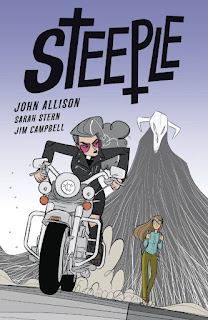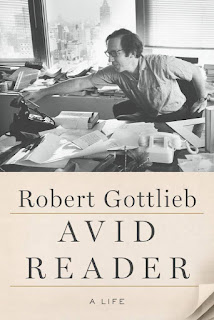It's
Black Hammer time again, baby!
This book collects a basically standalone story set in the same universe as the cluster of superhero stories mostly set in the present day - I've most recently hit The Quantum Age - four comics issues that were collected into this book in 2019 soon after their original publication.
This time out, series creator Jeff Lemire just co-plotted with Ray Fawkes, who wrote the script. And new-to-the-series creator Matt Kindt is the artist, with some pin-ups (sorry, "chapter breaks") by other hands. Those are three of the very best American comics-makers of their generation, three thoughtful and skillful men whose time is usually spent on weightier matters than "Hey! What is the Blackhawks were actually Black?"
Spoiler alert! That's the whole point here. Like everything else in the Black-Hammer-verse, Black Hammer '45 is made up of scavenged pieces of old superhero comics stories, re-arranged to tell very much the same kind of stories in ways that will not get Jeff Lemire sued by the suits at (most often) Warner. As usual, I am baffled that grown men think this is the best use of their limited time and professional skills, but I've come to realize that a lot of people like stories of punching in spandex vastly more than I ever have.
We do get a very loose frame story, set seventy years later - basically the same "present day" as the other comics, for the continuity nerds who are the assumed audience - but that's mostly there to signpost that not all of the characters survived the main story. That main story is The Last Flight of the Black Hammer Squadron: I may slightly overdramatize it but only by giving it that title.
It is April of 1945. American forces (oh, and maybe other Allies, but who cares about them?) are pushing East towards the borders of Germany. Meanwhile, Soviet (boo! hiss! they may be our allies now but we know they won't be for long!) forces are doing the same from the West. As usual in a four-color universe, it seems that all of the events of the real-world war happened, plus a lot of superhero-fighting as well on top of it, and we get some quick single-panel flashbacks to show what the Black Hammer Squadron, and the more conventionally superheroic Liberty Squadron, have been up to for the past three years.
The BHS - my apologies; I just can't keep typing out the full title - is made up of three pilots and their mechanic, all of whom are what the "Who's Who" of this universe would term "of above-average athletic ability and skill in both hand-to-hand and aerial combat" while sniffing that they possess "no true super-powers." The head is Captain Hawthorne, sole survivor of the three brothers who made up the original BHS. The other two pilots at the end of the war are Jean-Paul, who is both our narrator and very, very obviously French in the manner of Blackhawk comics, and Li, who doesn't get a lot of background but who, from his name, I assume is Chinese. In a stunning break from their Blackhawk models, Li is not presented in any deeply racist way at any time.
The mechanic might have a name. If he does, I missed it. He only gets a couple of lines, and is left back at base for the vast majority of the book.
This Last Mission is to save the Greenbaum family - dad scientist, mom scientist, son probably-not-a-scientist-yet (but I would bet dollars to donuts he's one of the first Science Heroes! of this universe around about 1961) - who are being held in a Nazi compound (commanded by what seems to be a werewolf for no obvious reason I caught) that is So Secret It Doesn't Even Have a Name! [1]
Also making a beeline for The Compound So Secret Everyone Knows About It are the giant robot mechs of the Soviet Red Tide, led by the usual Plucky Young Woman Who Has Seen Great Tragedy, Since Russia Is The Land of Great Tragedy. (Forgive me if I don't dig out her name: she's there to be Russian, to shoot missiles at Nazis, and to fail at her mission since she's in conflict with Americans.)
Also also in the mix is the Ace of All Aces of All Aces, Ghost Hunter, who has racked up more confirmed kills than there have been days of aerial combat so far during the war. He also, inevitably, was the killer of Hawthorne's two brothers, so this is not only the Last Mission, but, even more importantly, This Time It's Personal.
Do the BHS make it to the unnamed compound? Do they battle Ghost Hunter there? Does the Red Tide get destroyed by the Ghost Hunter to show how badass he is? Are there battles in the sky and on the ground? Do characters we know from the other Black Hammer stories make Important Cameo Appearances? Do the clichés fall like rain upon the battlefield?
Dear Reader, you know they do.
Matt Kindt's scratchy, determinedly anti-heroic art style is kind of an odd choice here, but he's done a lot of WWII-adjacent stuff, so maybe that's it. I always like his art, because it's organic and specific - no one else draws like him - but it's not what you'd expect in a story of the Black Blackhawks and their Epic Battles With Nazi Aces and Giant Soviet Robots.
As always, I enjoy Black Hammer stories for close to the complete opposite reasons the creators expect: they are so obvious, so dumb, so silly. Nothing else in the world shows the core decadence and pure Kabuki nature of contemporary superhero comics the way Black Hammer does. It is impressive in its purity, its utter commitment to the bit.
[1] Int. Day. Berlin. Bunker.
HITLER: Achtung! Give me a report on the secret compound!
HIMMLER: Yes, Fuhrer! Early tests on the Odinspear are promising...
HITLER: Nein! Not that secret compound! The one outside Vienna!
HIMMER: West of Vienna or South of Vienna?
HITLER: West, you schweinhund!
HIMMER: Oh, right, the Greenbaums.



















